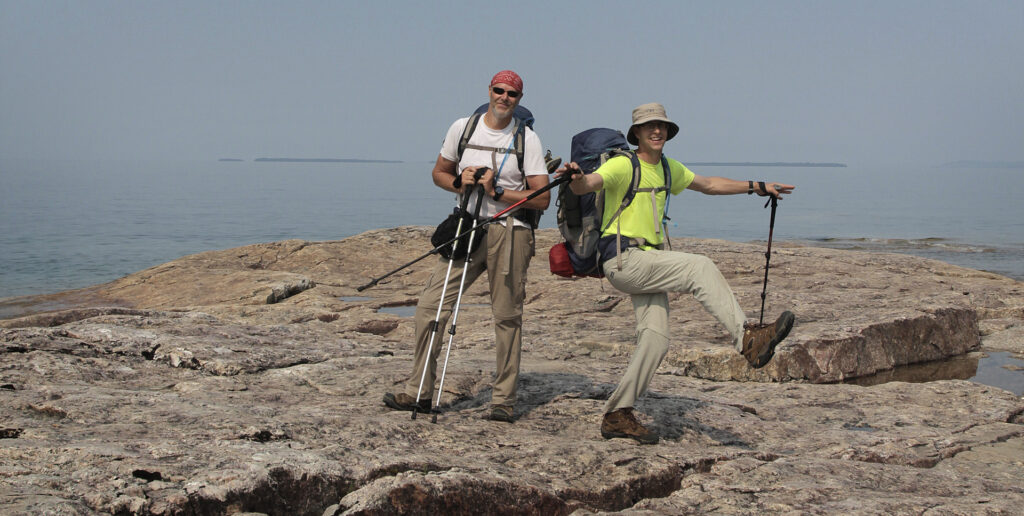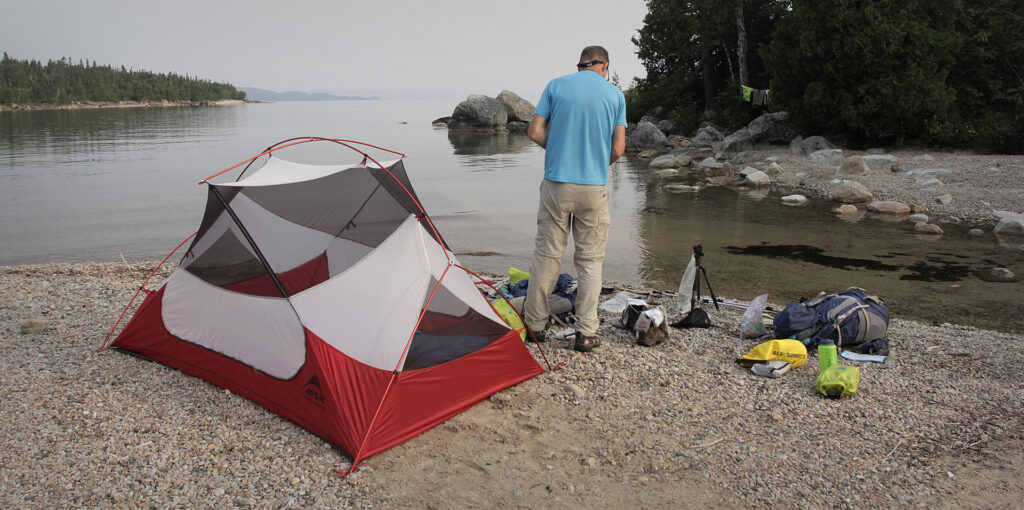
WILDERNESS TRAILS – 6 DAYS ON LAKE SUPERIOR’S COASTAL TRAIL
We were warned that this trail was not for novice hikers. The beauty of this landscape is possibly only equalled by its ruggedness. I suppose that’s part of the reason why it is so spectacular – because of how rugged and remote it is.
It had been 17 years since the first time I witnessed the beauty of Lake Superior’s east coast – 8 years since I was there last. Two years since our last project – Scott and I were long overdue for another hike. Sponsorship needed to be secured, new equipment purchased, permits obtained and a weeks worth of dehydrated meals needed to be made. The genesis of this trip was years in the making, but we had only months to prepare.
As we stepped onto that beach at Agawa Bay – on a warm, sunny August morning – ten months of anticipation was finally released. And with an endless supply of optimism and energy, we bolted down that sandy shoreline, revelling in the fact that we were finally there. Now, before you get the wrong idea, this is not a story about a leisurely afternoon at the beach. That beach would shortly change into the most difficult and beautiful trail, we would ever hike.
Are We There Yet? (Agawa Bay – Barrett Island)
The sandy beach, we had started from, had changed to mostly small stones after we crossed the Agawa River. From Agawa Point to Sinclair Cove we hiked under the shade of trees, high above the vertical cliffs, periodically coming to sun filled openings with stunning views looking out to the Agawa Islands, Gainly Island, Rock Island and Sinclair Island. For the majority of the hike we encountered no one on the trail. Once in a while, we would briefly cross paths with hikers travelling south bound. We shared good conversation with a father & son expedition near the Baldhead River and a couple of times shared a campsite – once at Robertson Cove with some college students from Michigan and another at Gargantua Bay, with a local couple on the first night of their hike.
I might walk for an hour most days, but never for 6 – 10 hours a day. I must confess, that about mid afternoon, I start wondering “are we there yet?” If you want to get to know a place, just hike through it! While you are out here, familiarity with the land is inevitable when you travel at a few kilometers an hour, touching every aspect of the trail, noticing every intimate detail of the environment you pass through. This also becomes necessary for navigational purposes – along with our constant awareness of trail markers and a few visual checks of the map. Through the process of a multi-day hike, I better understand the idea of being one with the land.
There were sections of trail that we longed for the shade of the inland forest, while other times longing to be out, to smell the fresh lake air and to feel the cool lake breeze blow across our sweat soaked shirts. Many portions of the trail alternated between flat forest and sections of trail that tested our hand, foot and eye coordination. It was on top of these boulders, sometimes 3 – 6 feet in diameter, that were some of the most dangerous stretches of trail we faced. The elevation changes were – let’s just say interesting. Bald Head, was intensely steep in places, often requiring us to climb up on hands and knees and sometimes requiring pack removal and scaling down sections backwards. Even the long sections of beach could not be considered truly flat because of the sideways slope caused by the waves creating a terraced like effect, with the many sizes of loosely packed stones.
It’s a strange feeling to know where you’re going, but not know where you’re going. Let me explain. While we had maps reassuring us what’s ahead and where we were, we didn’t really know what to expect, since it was our first time on the trail. Every moment was always a new experience. I found it fascinating to see the reality of where we were, compared to what we had imagined. It’s not like the drive to work, where we could tune out our environment and successfully auto pilot ourselves to work. Out here you need to pay attention to the markers or, you very quickly find yourself bushwacking. It takes a concentrated effort to navigate the landscape and appreciate the beauty that awaits us at every twist and turn of the trail.



A Sacred Space (Barrett Island – Robertson Cove)
Every thing out here is so new to us – a bit overwhelming at times. The sites, sounds and smells are all unlike anything we’ve experienced before. Being out here for a couple of days now, it doesn’t take long to begin to see the landscape in a new light. The trees, the presence of the lake, the rock, the shoreline all start to become familiar. We start to anticipate the twists and turns – the ups and downs. It all starts to feel comfortable and normal to be here and to be hiking all day long, instead of driving where ever we need to go. A sense of belonging grows stronger with each passing day out here.
Hiking this part of the country is such a beautifully diverse experience. You will witness steep granite rock faces plunging into the lake, long expanses of coastal beaches, the most beautiful assortment of white pine, cedar, aspen, hemlock and jack pine I have ever seen – boulder beaches, gently sloping rock terraces and pristine rivers flowing from inland hills, into the largest freshwater lake in the world.
Something that’s sacred is dedicated or set apart for the service or worship of a deity or inspiring awe. This characteristic is often ascribed to objects or places. Wilderness areas like this have been set apart and protected, so as to preserve its primeval character and influence. In these sacred spaces, we move about as mere visitors, the landscape inspiring in us awe and reverence. Out here, you will find very few signs of man’s influence. I guess part of the lure of places like this, is that they are rare, almost hard to find and difficult to get to.
The gravel and sand beaches of Agawa Bay, Katharine Cove and Sand River are walkable, although the softness of the pack and the angle of the shore puts an unnatural stress upon the muscles running up the shins. The many rivers that intersect with the lake – Agawa, Baldhead, Coldwater, Sand – all give us a brief moment of distraction from the usual structure of the trail. The caves, driftwood, shoreline, the crevices, the scenic lookouts, beaches – they all challenge us to make it to our desired destination before the sun goes down. As tempting as it is to linger and play, trudging into camp, in the dark, is not a good plan.




A Place to Rest (Robertson Cove – Bald Head River)
About mid afternoon, after spending the day wandering through the wilderness, following trail markers and stopping at strategic locations to refill our water supply or simply rest and enjoy the view, we start to think about our final rest stop for the day. It’s this nomadic lifestyle that keeps us wondering where we will find a place to rest for the night.
One of our highlights each day was arriving at the campsite. Here, we could remove all the necessities of the day’s hike – the heavy pack (that started out at 45 lbs.), hiking boots & socks and the accumulation of sweat and grime, which was removed with a swim in the lake.
The daily grind, with all its discoveries is satisfying, but not as satisfying as the thought of spending a bit of time at the most remote and scenic campsite you could ever imagine. The most dramatic or mysterious part of the day was experienced at the place we called home for only a short period of time. We’d see the sun set over the lake each night and the following morning, we would witness the sunrise over the inland hills. Some nights, after dinner was finished, we’d have an hour or two to explore the area and enjoy everything that the camp site had to offer.
Each location had its own unique personality. Most sites were structured in much the same way – tent pad and fire pit nestled just inside the treeline, with a beach area in between that and the lakeshore. Our last night on Gargantua Bay had a generous view of the lake while others had no view to speak of. Beaches were comprised of small pebbles, large rocks or sand. Our site where the Bald Head River flowed into Lake Superior had a south facing lake access as well as west facing. Most sites had a view to the south-west. Our favourite site at Robertson Cove was unlike all the others. It was a sandy spit of land that was just high enough to provide dry access to the small island located just off shore.
Regardless of the personalities of each camp site, the same essentials – relaxation, nutrition and rest – were enjoyed each night. Depending on what time of day we arrived at camp, determined what we could fit in and still get to bed at a reasonable time. If we arrived early enough, there would be time to explore the nearby surroundings, enjoy a fire, spend some time in a favourite book and appreciate a Superior sunset.
The Pilgrim’s Regress (Bald Head River – Buckshot Creek)
I’ve heard an expression that sheds a bit of light on the experience of a multi day hike – “You can’t take the grim out of pilgrimage”. The word pilgrimage is defined as “a journey, especially a long one, made to some sacred place as an act of religious devotion.” I can’t say for certain that there was religious devotion as cause for our trip, but the experience did feel sacred.
Hiking in locations like this can be tough at times! As fellow travellers, Scott and I would experience both individual and shared challenges. Usually the physical demands of a multi-day hike will affect you first and possibly – or probably followed by some form of emotional or mental strain. If it is not the arduous climb up another steep incline – trying to manage the exhaustion, muscle cramps, some degree of dehydration, it will happen in the mind – arguing with yourself whether to rest or not – again, whether to give up and retreat – hoping to hitch a ride back to your vehicle or drinking more water, when you really would rather drink anything but water. Sometimes we went from spiritual epiphany to exhausted defeat in the space of minutes, our emotions changing as quickly as the waves pounding the shoreline.
To make the pilgrimage, a lot less grim, patience and understanding are required of yourself and of your travelling companions. Successful hikes like these, are a team effort! A bit of experience also goes along way too. After having completed and endured previous hikes, you can rely on that experience to give you hope – that most trials are temporary and will soon pass. Having realistic expectations and the ability to be flexible with them, helps keep the journey as painless as possible.



H2O (Buckshot Creek – Gargantua Bay)
Out here, water is one of the essentials for survival. On the Coastal Trail, we didn’t have to carefully plan our consumption and retrieval that carefully. The lake was always within reach of a thirsty hiker.
It was always within reach of an overheated hiker as well. A swim during lunch break was anticipated long before arrival. In mid August, swimming in Superior’s sheltered coves, is the warmest you will ever experience. I love being immersed in such a powerful body of water, in such an intimate setting and security of the many coves and inlets along the shoreline. Some have sand beaches, most are pebble, with larger boulders lying under the water just off shore.
It is here at these pebble beaches that you hear the song of Superior. Waves unfolding onto shore, and then retreating – the small, smooth pebbles that have made the round trip onto shore and back, thousands of times. The push and pull of the water sorts the stones along the shore perfectly according to size. Stones the size of eggs are tossed on shore and are pulled back out, their hard and smooth surfaces colliding and clicking like the sound of a geiger counter.
The many rivers that interrupted our trail served as markers of our progress, tangible sign posts that we were indeed, albeit slowly, moving toward our goal. We could walk over or through some of them, while others led us upstream to a foot bridge or sometimes all the way up to the highway and back. They were usually cold and clear, having made the journey through miles of shaded forest of the Algoma Highlands.
This is a big lake! Superior is the dominant feature of this trail. It balances and contrasts the land quite beautifully. The forest, at times can be thick and fragrant. As soon as the trail leads you out into the open areas of treeless, rocky shoreline you are suddenly confronted by space, wind, light and an endless line where sky meets water – the vastness of Lake Superior.
The Coastal Trail is both thrilling and terrifying. The trail gives and takes something away from the hiker. The power and size of the lake, the need to cross this rugged wilderness in such remoteness and solitude, all set the stage for an extremely humbling experience. But, the big-sky views, the intimacy you get with hiking, and the satisfaction of successfully completing a very difficult journey, help to restore your capacity to appreciate the awesome beauty and sacredness of wilderness areas like this. As it is in all relationships, the Lake Superior coast has to be respected before it can be truly appreciated. After spending nearly a week out here, I can begin to have a deeper appreciation of the beauty of, and a healthy respect for the ruggedness of Lake Superior’s Coastal Trail.

